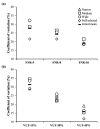The Bench Press Grip Width Does Not Affect the Number of Repetitions Performed at Different Velocity Loss Thresholds
- PMID: 33504038
- PMCID: PMC7908121
- DOI: 10.3390/ijerph18031057
The Bench Press Grip Width Does Not Affect the Number of Repetitions Performed at Different Velocity Loss Thresholds
Abstract
This study aimed (I) to compare the number of repetitions that can be completed to failure (XRM) and before reaching a 15%, 30%, or 45% velocity loss threshold (XVLT) in the bench press exercise performed using different grip widths, and (II) to examine the inter-individual variability in the percentage of completed repetitions with respect to the XRM when the set volume is prescribed based on a fixed number of repetitions (FNR) and several velocity loss thresholds (VLT). Nineteen men performed four separate sessions in a random order where there was a single set of repetitions completed to failure against 75% of the one-repetition maximum during the Smith machine bench press exercise using a narrow, medium, wide, or self-selected grip widths. The XRM (p = 0.545) and XVLTs (p ≥ 0.682) were not significantly affected by grip width. A high and comparable inter-individual variability in the percentage of completed repetitions with respect to the XRM was observed when using both an FNR (median CV = 24.3%) and VLTs (median CV = 23.5%). These results indicate that Smith machine bench press training volume is not influenced by the grip width and that VLTs do not allow a more homogeneous prescription of the set volume with respect to the XRM than the traditional FNR.
Keywords: fatigue; resistance training; training prescription; training volume; velocity-based training.
Conflict of interest statement
The authors declare no conflict of interest. The funders had no role in the design of the study; in the collection, analyses, or interpretation of data; in the writing of the manuscript, or in the decision to publish the results.
Figures

Similar articles
-
Number of Repetitions Performed Before and After Reaching Velocity Loss Thresholds: First Repetition Versus Fastest Repetition-Mean Velocity Versus Peak Velocity.Int J Sports Physiol Perform. 2021 Jul 1;16(7):950-957. doi: 10.1123/ijspp.2020-0629. Epub 2021 Mar 10. Int J Sports Physiol Perform. 2021. PMID: 33691279
-
Prediction of the Maximum Number of Repetitions and Repetitions in Reserve From Barbell Velocity.Int J Sports Physiol Perform. 2018 Mar 1;13(3):353-359. doi: 10.1123/ijspp.2017-0302. Epub 2018 Mar 14. Int J Sports Physiol Perform. 2018. PMID: 28771050
-
Inter-repetition Rest Impact on Percentage of Repetition Completed at Certain Velocity Loss.Int J Sports Med. 2024 Feb;45(2):116-124. doi: 10.1055/a-2200-5937. Epub 2023 Dec 18. Int J Sports Med. 2024. PMID: 38109899
-
Influence of the grip width on the reliability and magnitude of different velocity variables during the bench press exercise.Eur J Sport Sci. 2020 Oct;20(9):1168-1177. doi: 10.1080/17461391.2019.1704068. Epub 2020 Jan 4. Eur J Sport Sci. 2020. PMID: 31825728
-
The fastest repetition in a set predicts the number of repetitions completed to failure during resistance training: The impact of individual characteristics.Physiol Behav. 2023 Jun 1;265:114158. doi: 10.1016/j.physbeh.2023.114158. Epub 2023 Mar 15. Physiol Behav. 2023. PMID: 36925096
Cited by
-
Using cluster and rest redistribution set structures as alternatives to resistance training prescription method based on velocity loss thresholds.PeerJ. 2022 Mar 29;10:e13195. doi: 10.7717/peerj.13195. eCollection 2022. PeerJ. 2022. PMID: 35368341 Free PMC article.
-
Maximal Number of Repetitions at Percentages of the One Repetition Maximum: A Meta-Regression and Moderator Analysis of Sex, Age, Training Status, and Exercise.Sports Med. 2024 Feb;54(2):303-321. doi: 10.1007/s40279-023-01937-7. Epub 2023 Oct 4. Sports Med. 2024. PMID: 37792272 Free PMC article. Review.
-
Bench Press Range-of-Motion and Velocity-based Repetition Control: Effects on Ballistic Push-up Performance in Males.Int J Exerc Sci. 2024 Jan 1;17(1):38-53. doi: 10.70252/USAK1758. eCollection 2024. Int J Exerc Sci. 2024. PMID: 38665164 Free PMC article.
References
-
- De Weese B.H., Hornsby G., Stone M., Stone M.H. The training process: Planning for strength–power training in track and field. Part 2: Practical and applied aspects. J. Sport Health Sci. 2015;4:318–324. doi: 10.1016/j.jshs.2015.07.002. - DOI
-
- Weakley J., Mann B., Banyard H., McLaren S., Scott T., Garcia-Ramos A. Velocity-based training: From theory to application. Strength Cond. J. 2020 doi: 10.1519/SSC.0000000000000560. in press. - DOI
MeSH terms
LinkOut - more resources
Full Text Sources
Other Literature Sources

